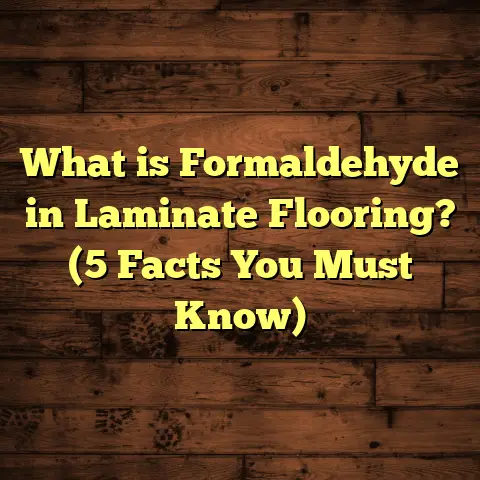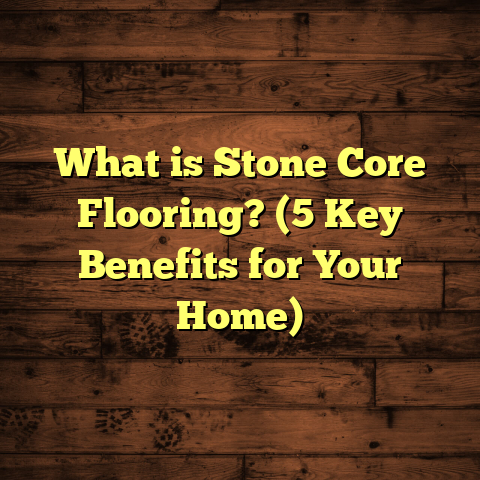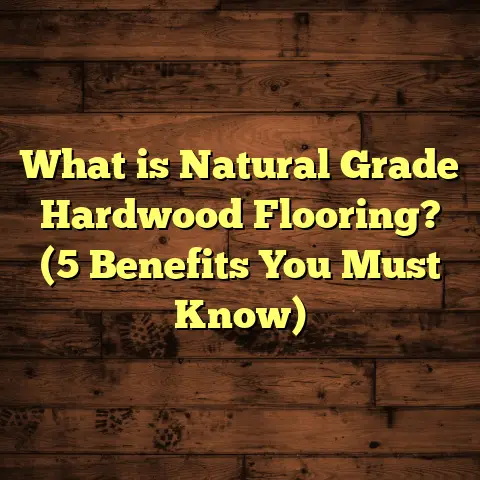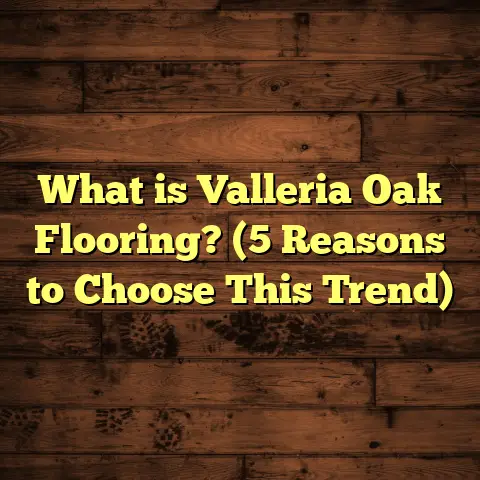What Is Floor Hazing? (5 Key Causes & Solutions Revealed)
Have you ever spent a solid chunk of time cleaning your floors, only to step back and notice they look… off? Like there’s a faint cloudy film or haze dulling their shine? It’s maddening. You cleaned, you polished, yet your floors seem to have lost their glow. That cloudy layer is what we call floor hazing.
In my years working with all kinds of flooring—from hardwood in cozy homes to slick vinyl in offices—I’ve seen floor hazing more times than I can count. It’s frustrating for homeowners and contractors alike because it hides the true beauty of your floor and can be tricky to fix without knowing the cause.
Let’s talk about what floor hazing really is, why it happens, and how you can tackle it head-on with practical solutions that actually work.
What Is Floor Hazing?
Simply put, floor hazing is a faint, cloudy residue or film that appears on the surface of floors. It dims the natural shine and clarity of the flooring material, making even a new or well-maintained floor look dull or “foggy.” This haze doesn’t come from dirt or dust; it’s usually a buildup of unseen residues or surface contamination.
Floor hazing can show up on many types of floors—hardwood, laminate, vinyl, tile, sealed concrete—you name it. It often looks like a whitish film but can sometimes appear as streaks, smudges, or a chalky layer that doesn’t wipe away easily.
How I First Noticed Floor Hazing
When I started my flooring career over a decade ago, I worked on refinishing a gorgeous oak hardwood floor in a client’s living room. After sanding and applying three coats of finish, the floor still looked dull under the sunlight streaming through the window. The finish was flawless, but there was this thin, ghostly haze across the surface. It threw me for a loop.
After some trial and error—and digging into the causes—I realized it was floor hazing caused by leftover sanding dust trapped under the finish. That experience taught me to pay close attention to surface prep and dust control during every step.
Why Should You Care About Floor Hazing?
You might wonder if floor hazing is just an aesthetic issue. Well, mostly yes—it affects how your floors look and feel. But it can also be a sign that something else is off with your floor, like moisture problems or poor maintenance habits. Ignoring hazing means your floors lose their luster and might wear out faster due to trapped residues interfering with finishes.
From a resale perspective, dull floors can hurt your home’s value or curb appeal. And if you’re a contractor or DIYer, hazy floors reflect poorly on your workmanship.
1. Residue from Cleaning Products: The #1 Cause I See
This is by far the most common cause of floor hazing I encounter. People want clean floors but end up using the wrong products or improper methods that leave behind unseen residue.
Why Does This Happen?
Many household cleaners contain soaps, waxes, or detergents not formulated for your specific floor type. When these products aren’t fully rinsed off or dry on the surface, they create a faint film. Over time, this residue builds up into a haze that dulls shine.
What makes this tricky is that some cleaners even advertise as “floor safe” but aren’t ideal for hardwoods or laminates—especially if they have wax or oil additives.
My Personal Story
I once helped a homeowner who was obsessed with keeping her floors spotless. She used a popular all-purpose cleaner daily on her engineered hardwood. After months, the floors looked cloudy despite regular mopping. When I inspected, I noticed a sticky waxy film coating the boards.
We stripped the residue using a hardwood floor cleaner designed to remove wax buildup and switched her to a neutral pH cleaner recommended for hardwoods. After that, her floors regained their shine within days.
How to Avoid Cleaning Product Residue Hazing
- Use pH-neutral cleaners made for your specific flooring.
- Avoid soap-based or wax-containing products unless explicitly recommended.
- Rinse floors with clean water after cleaning to remove any leftover product.
- Dry floors promptly with microfiber mops or cloths.
- Don’t overwet floors; excessive water encourages residue buildup.
Quick Test for Residue
Try wiping a small area with a damp microfiber cloth dipped only in water. If the haze lifts slightly, you’re likely dealing with residue buildup.
2. Excessive Moisture: The Silent Floor Killer
Moisture is one of the sneakiest causes of floor hazing and damage. Floors hate standing water or excess humidity because it can cause finishes to swell or minerals to deposit on surfaces as white haze.
The Science Behind It
When water seeps into seams or pores of flooring materials—especially hardwood or laminate—it can swell wood fibers and interfere with finish adhesion. Minerals dissolved in water (like calcium and magnesium) sometimes crystallize on drying surfaces, leaving white deposits that look like haze.
Humidity levels above 60% can also soften finishes and attract dust particles that settle into a foggy layer.
Real-World Example
I installed vinyl planks in a basement with poor drainage. The homeowner reported hazy patches near an exterior door after rainy days. Moisture was seeping in under the door frame causing finish swelling and mineral buildup.
We fixed it by sealing gaps, adding proper weather stripping, and installing a dehumidifier to maintain indoor humidity around 45%. The haze disappeared completely within weeks.
How to Protect Floors from Moisture Hazing
- Wipe spills immediately—don’t let water pool.
- Use absorbent mats at entrances and near sinks.
- Maintain indoor humidity between 35–55%.
- Fix leaks or drainage problems promptly.
- Avoid steam mops or excessive water when cleaning.
3. Dust from Sanding or Installation: A Contractor’s Nightmare
During sanding or refinishing jobs, dust control is critical. Tiny dust particles settle everywhere—including on your floor finish—if not properly contained.
Why Does Dust Cause Hazing?
Fine dust particles trapped in wet finish coats dry into an uneven film that looks milky or cloudy once cured.
My Experience on Job Sites
I’ve worked on jobs where dust extraction systems weren’t working properly or workers skipped cleaning between sanding passes. The result? Floors full of hazy spots even though the finish application was perfect.
Steps to Prevent Dust Hazing
- Use professional dust extractors during sanding.
- Clean surfaces meticulously between coats using tack cloths.
- Vacuum and wipe down the entire area before finishing.
- Apply finishes in a clean, dust-free environment.
- Allow sufficient drying time between coats to prevent trapping particles.
Fixing Dust-Induced Haze
If haze shows up after finishing:
- Lightly buff the floor with fine grit sandpaper or abrasive pads.
- Apply an additional thin finish coat.
- If necessary, call in pros for recoating or deep cleaning.
4. Wax Build-Up: When Too Much is Too Much
Waxed floors have their charm but can become problematic over time if wax layers accumulate unevenly.
How Does Wax Cause Haze?
Each time you apply new wax without stripping old layers first, you add thickness that traps dirt and creates an uneven matte film over your floor’s surface.
Personal Story: Wax Woes
A couple called me distressed about their vinyl floors looking dull and sticky despite regular waxing. Upon inspection, I found multiple old wax layers were caked on unevenly.
We stripped all old wax with recommended products, cleaned thoroughly, then applied fresh thin coats of wax evenly. The difference was night and day—the floors were glossy again without any haze.
Managing Wax Layers
- Strip old wax completely before applying new layers.
- Use recommended wax strippers for your floor type.
- Apply thin coats evenly; avoid heavy builds.
- Don’t mix wax types (e.g., don’t put polyurethane over wax).
- Consider switching to modern sealants if waxing maintenance feels too tedious.
5. Hard Water Deposits: An Unexpected Culprit
Hard water contains minerals like calcium carbonate that can leave white spots after mopping or cleaning if not managed properly.
How Does Hard Water Cause Haze?
When hard water evaporates off the floor surface, minerals stay behind as white crystalline deposits that appear as haze or spots.
Case Study: Hard Water Hazing
In an area famous for hard water supply, I noticed repeated hazing on laminate floors after customers mopped with regular tap water. Switching them to use distilled water mixed with mild vinegar eliminated the mineral deposits completely.
Solutions for Hard Water Hazing
- Mop with distilled or filtered water.
- Add mild vinegar (1 cup per gallon) to mop water to break down minerals.
- Dry floors immediately after cleaning.
- Look into whole-house water softening systems if hard water is persistent.
Common Misconceptions About Floor Hazing
Let me clear up some myths I often hear:
- Myth: Floor hazing means my floor finish is defective.
Truth: Usually hazing is about surface contamination—not finish failure. - Myth: More cleaning makes hazing go away.
Truth: Over-cleaning or wrong cleaners often worsen hazing by adding residue. - Myth: I can fix haze by just waxing over it.
Truth: Wax traps haze underneath; stripping is needed first.
Knowing these helps you avoid costly mistakes.
Advanced Tips for Tackling Tough Floor Haze Problems
Sometimes haze won’t clear up with simple cleaning or rinsing. Here’s what works when things get stubborn:
- Deep Clean: Use professional-grade floor cleaners designed for residue removal specific to your flooring type.
- Buffing: Mechanical buffing with fine abrasives can restore clarity by removing top layers of haze.
- Recoating: Applying fresh finish coats after proper prep often restores shine.
- Professional Help: Don’t hesitate to call in flooring pros for refinishing if DIY fixes fail.
How To Diagnose Your Floor Haze Like A Pro
Here’s a quick step-by-step you can try:
- Check when haze appears: After cleaning? After installation? After waxing?
- Try wiping with water: If haze lifts – residue likely from cleaners or wax buildup.
- Look for moisture: Is haze near wet areas/spills? Could be moisture damage.
- Inspect dust: Is haze appearing right after sanding/finishing? Dust contamination possible.
- Test mop water: Use distilled water on a small spot to see if haze reduces – hard water may be culprit.
How Often Should You Clean And Maintain To Prevent Hazing?
Maintenance frequency depends on traffic but here’s my rule of thumb:
- Daily/Weekly: Dry mop or vacuum to remove dirt/grit (which wears finishes).
- Monthly: Damp mop with appropriate cleaner (avoid overwetting).
- Yearly: Deep clean using residue-removing products tailored for your floor type.
- Every Few Years: Professional refinishing or recoating as needed based on wear/haze presence.
Tools & Products I Recommend For Keeping Floors Haze-Free
Here are some trusted brands and tools I’ve used:
| Product Type | Recommended Brands/Tools |
|---|---|
| Hardwood Cleaner | Bona Hardwood Floor Cleaner |
| Laminate Cleaner | Rejuvenate Laminate Floor Cleaner |
| Wax Stripper | Armstrong Wax Remover |
| Microfiber Mop | O-Cedar EasyWring Microfiber Mop |
| Dust Extraction | Festool CT Mini Dust Extractor |
| Buffing Pads | 3M Fine Abrasive Pads |
Using the right tools makes all the difference!
Why Patience Is Key When Dealing With Floor Hazing
Fixing hazy floors isn’t always instant—some treatments take time to show results as residues dissolve or finishes cure fully. Don’t rush waxing or refinishing immediately after cleaning attempts; give products time to work fully.
Final Thoughts: Your Floors Are Worth It
Floors are often the unsung heroes of home design—they set the tone for every room’s vibe and feel. Don’t let hazing steal your floor’s spotlight!
From my hands-on work with thousands of clients and projects, I’ve learned that identifying the cause accurately is half the battle won. Whether it’s leftover cleaning residues, moisture issues, sanding dust, wax buildup, or hard water minerals—the right fix exists.
Have you noticed floor hazing at home? What steps have you tried so far? Feel free to reach out anytime if you want help troubleshooting — I’m always happy to share what works best from my experience!
Your floors deserve to shine bright—let’s make sure they do.
If you want me to expand any specific section further with more case studies, step-by-step guides, technical details on finishes/types of flooring affected by hazing, or product recommendations—just say so!





